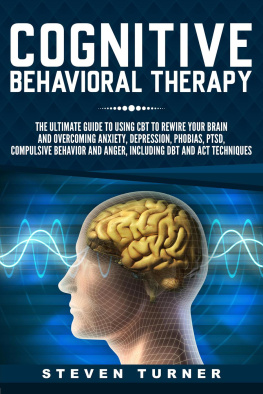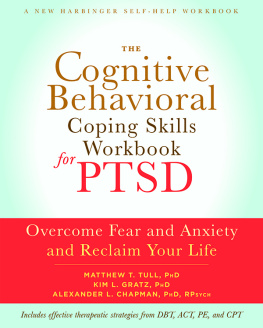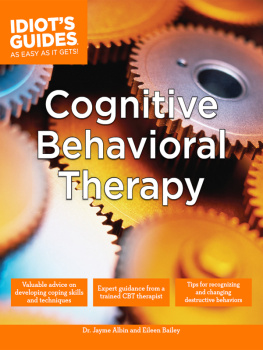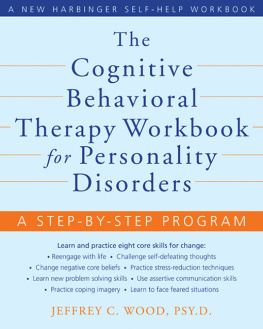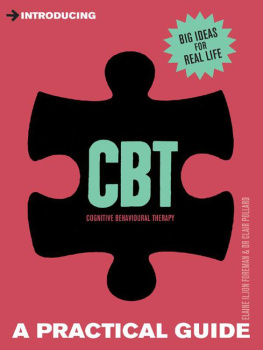Steven Turner - Cognitive Behavioral Therapy
Here you can read online Steven Turner - Cognitive Behavioral Therapy full text of the book (entire story) in english for free. Download pdf and epub, get meaning, cover and reviews about this ebook. year: 2020, publisher: Steven Turner, genre: Religion. Description of the work, (preface) as well as reviews are available. Best literature library LitArk.com created for fans of good reading and offers a wide selection of genres:
Romance novel
Science fiction
Adventure
Detective
Science
History
Home and family
Prose
Art
Politics
Computer
Non-fiction
Religion
Business
Children
Humor
Choose a favorite category and find really read worthwhile books. Enjoy immersion in the world of imagination, feel the emotions of the characters or learn something new for yourself, make an fascinating discovery.
- Book:Cognitive Behavioral Therapy
- Author:
- Publisher:Steven Turner
- Genre:
- Year:2020
- Rating:4 / 5
- Favourites:Add to favourites
- Your mark:
- 80
- 1
- 2
- 3
- 4
- 5
Cognitive Behavioral Therapy: summary, description and annotation
We offer to read an annotation, description, summary or preface (depends on what the author of the book "Cognitive Behavioral Therapy" wrote himself). If you haven't found the necessary information about the book — write in the comments, we will try to find it.
Cognitive Behavioral Therapy — read online for free the complete book (whole text) full work
Below is the text of the book, divided by pages. System saving the place of the last page read, allows you to conveniently read the book "Cognitive Behavioral Therapy" online for free, without having to search again every time where you left off. Put a bookmark, and you can go to the page where you finished reading at any time.
Font size:
Interval:
Bookmark:
Copyright 2018
All Rights Reserved. No part of this book may be reproduced in any form without permission in writing from the author. Reviewers may quote brief passages in reviews.
Disclaimer: No part of this publication may be reproduced or transmitted in any form or by any means, mechanical or electronic, including photocopying or recording, or by any information storage and retrieval system, or transmitted by email without permission in writing from the publisher.
While all attempts have been made to verify the information provided in this publication, neither the author nor the publisher assumes any responsibility for errors, omissions or contrary interpretations of the subject matter herein.
This book is for entertainment purposes only. The views expressed are those of the author alone, and should not be taken as expert instruction or commands. The reader is responsible for his or her own actions.
Adherence to all applicable laws and regulations, including international, federal, state and local laws governing professional licensing, business practices, advertising and all other aspects of doing business in the US, Canada, UK or any other jurisdiction is the sole responsibility of the purchaser or reader.
Neither the author nor the publisher assumes any responsibility or liability whatsoever on the behalf of the purchaser or reader of these materials. Any perceived slight of any individual or organization is purely unintentional.
 |  |


C ognitive behavioral therapy (CBT) is fast becoming one of the most sought methods of treatment for a variety of health complications, particularly mental and emotional health problems. The National Center for Biotechnology Information conducted research into the efficacy of cognitive behavioral therapy, and they found that not only did the treatment allay symptoms of various illnesses, but the results of the treatment were long-lasting! More people are testing the curative powers of CBT by the day, and this has created a demand for CBT therapists.
The purpose of this book is to provide a comprehensive look at what CBT entails. The book explores the various tools and techniques used in CBT therapy, how CBT can help people fighting against various mental illnesses, and the role of CBT in creating a perfectly balanced life.
CBT emphasizes a hands-on approach to problems; whereby the therapist helps the client comprehend the intricate web of their thoughts, emotions, and behaviors. The underlying philosophy of CBT is that before you can change a persons emotions or behaviors, you first have to change their thoughts.
For the success of CBT, a therapist and a client must get along and have a deep trust between one another. The goal is to break the cycle of unhelpful thought patterns.
 |  |


C ognitive behavioral therapy (CBT) is a form of psychotherapy that solves an individuals problems by helping them modify both their thoughts and actions. CBT takes on a practical approach toward solving problems. Its goal is to remedy toxic thought-patterns and behaviors that have contributed to a persons distress and thus restore happiness. CBT is commonly used in treating a number of problems, such as relationship issues, sleeping difficulties, drug abuse, anxiety, and depression.
One of the biggest advantages of CBT is its shortness. It takes about six to ten months for the treatment of most emotional problems. Clients attend weekly sessions or a session every two weeks, with each session lasting about an hour. During the session, the client bares their soul, and the therapist comes up with the strategies of solving the problem. The therapist introduces a set of principles to the patient. And these lifelong principles are to help the patient overcome their problems.
Psychologists consider CBT to be a blend of psychotherapy and behavioral therapy. Psychotherapy highlights the value of the personal meanings we ascribe to things and how thinking patterns start in early childhood. Behavioral therapy explores the connection between our challenges, behaviors, and thoughts. To achieve maximum results, psychotherapists must tailor CBT to the precise needs and character of every patient.
The History of Cognitive Behavioral Therapy
Aaron Beck, a psychiatrist, is the man that came up with cognitive behavioral therapy in the 1960s. During psychoanalysis, Aaron realized that some of his patients appeared to talk to themselves, a sign of internal dialogue, but the patients only reported a small part of these thoughts to him.
For instance, during therapy, the patient might think to herself, The therapist seems a bit cold today. Have I done something to annoy him? Such a line of thought could make the patient anxious. But then the patient says to herself, Maybe hes tired, or he had a terrible encounter with someone before coming here . The second thought would potentially make the patient go from anxious to comfortable and well-adjusted. Thus, by changing their thoughts, they get to change their feelings.
Aaron Beck found out that the connection between thoughts and feelings was crucial. He said that people werent always conscious of their emotion-filled thoughts, but they could be trained to recognize them. Beck thought that it was necessary for a person to identify their emotion-filled thoughts in order to remedy their problems.
The Place of Negative Thoughts
According to CBT, whatever happens to us is not liable for our frustrations, but the meaning that we ascribe to it. If something terrible goes down, it is the accompanying negative thoughts that will make us feel terrible, not the deed itself.
For example, if a woman is suffering from depression, she might think to herself, If I go to work today, Ill botch things up. I feel horrible . Because of believing her negative thoughts, she is going to call in sick and miss work. Shes the victim of her thoughts not her depression. She made an incorrect assumption. Maybe if shed gone to work, shed have found something to do and proceeded to be extremely productive. However, sitting at home for the whole day, the negativity increases tenfold, and shes thinking, Oh, Im such a letdown! Where do I go from here? The woman ends up feeling even worse than before. Her emotion-filled thoughts place her in a vicious cycle that sends her spiraling down into a continuously worse state.
Where Do These Negative Thoughts Come From?
According to Aaron Beck, the most negative thinking patterns are rooted in our childhood experiences. A child who never received parental love might grow up to want validation from the external world. For this, they will strive to do something extraordinary to capture everyones attention and bask in the validation that they will earn. But this might place the person in a situation known as a dysfunctional assumption. This is where a previously unloved person assumes that they always have to do something great in order to be loved by people, and this notion makes them pursue success relentlessly, yet when they experience failure, the dysfunctional assumption is activated, and they start perceiving themselves as failures who will never recover.
Font size:
Interval:
Bookmark:
Similar books «Cognitive Behavioral Therapy»
Look at similar books to Cognitive Behavioral Therapy. We have selected literature similar in name and meaning in the hope of providing readers with more options to find new, interesting, not yet read works.
Discussion, reviews of the book Cognitive Behavioral Therapy and just readers' own opinions. Leave your comments, write what you think about the work, its meaning or the main characters. Specify what exactly you liked and what you didn't like, and why you think so.

